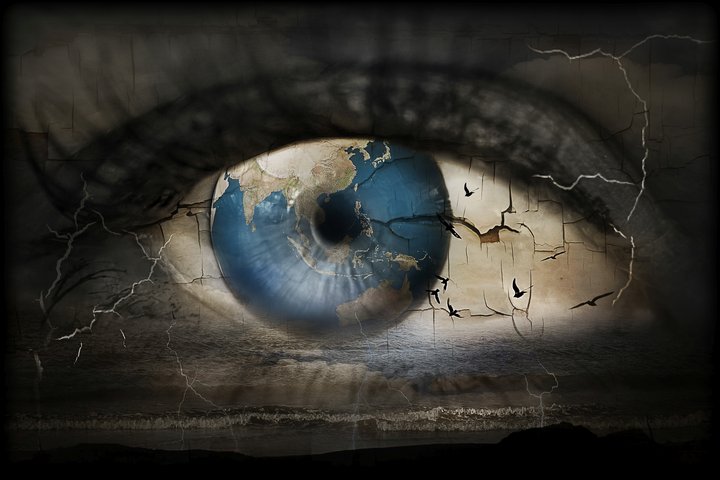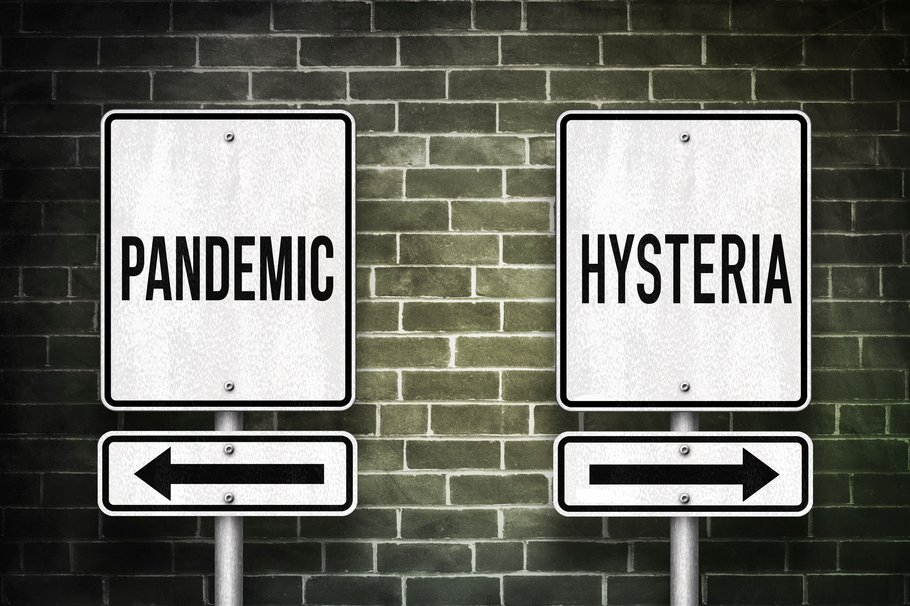This article is about the fact that the assessment of potential scenarios is increasingly based on a dubious approach to uncertainty as well as an uncritical approach to information. Quite a few people are caught in a perception trap and "filter bubble" and seek confirmation for what they already believe or consider to be true. The "mechanism of cognitive dissonance reduction" simplifies complex relationships in a seemingly simple picture. This leads to the fact that everything someone takes in in terms of information is first filtered according to whether I consider this information desirable or not. Serious risk assessment and the analysis of sensible preventive or reactive measures, however, require a scientific discourse and an interdisciplinary risk analysis based on facts and sound methods beyond "perceived truths". Here, we should above all accept that nothing is "by nature" this way or that (and therefore right or wrong).
The German sociologist Ulrich Beck had already coined the term risk society decades ago [cf. Beck 1986, p. 25]. Behind this is the thesis that in advanced modernity the social production of wealth is systematically accompanied by the social production of risks. Accordingly, the distribution problems and conflicts of the society of scarcity are superimposed by the problems and conflicts arising from the production, definition and distribution of scientifically and technically produced risks. According to Beck, there is a "shift from the logic of wealth distribution [...] to the logic of risk distribution." [Beck 1986, p. 25]
However, if we take into account that the assessment of risks is increasingly based on a (socially or politically) desired perception of potential risks and that facts are frequently manipulated or hidden [cf. Jun, Y./Meng, R./Johar, G. V. 2017, Heilmann 2021, Renn 2019, Romeike 2020a and Romeike 2020b as well as, in the context of climate science, Vahrenholt/Lüning 2020], we should rather speak of a risk perception society instead of a risk society.
Risk is a construct of our perception – and that is fundamentally a good thing, since this characteristic has enabled us to survive since the starting signal for humanity in Africa about six million years ago. Our perception as well as the evaluation of risks depend on what our senses condense into an overall picture. Our knowledge, emotions, values, moral concepts, fashions, judgements and opinions determine this construct. What one person perceives as a risk does not necessarily have to be a risk for another [cf. Romeike/Hager 2020, p. 61 ff., Kahneman 2011 as well as Romeike 2006].
Furthermore, risk perception is based on hypotheses. As a result, different assumptions and theories are often made for the same risks. The discussion about the risks of genetic engineering, climate change or the Covid 19 pandemic are xamples of the subjectivity of (societal) risk perception. The discussions in the context of genetic engineering on the one hand represent the "perceived" opportunities in plant breeding, animal husbandry, food industry and medicine and on the other hand "perceived" ethical objections. Moreover, potential risks are assessed completely differently for mRNA vaccinations (messenger RNA, messenger ribonucleic acid) than the use of genetic engineering in agriculture or the food industry.
Renn provides a variety of practical examples of this "risk paradox" of risk perception [cf. Renn 2014]. He shows that since the 18th century our life expectancy has been continuously increasing. The chances of living to be significantly older than eighty are growing from year to year. Nevertheless, in studies, the people surveyed regularly state that they lead a high-risk life and are "scared to death". The respondents often ignore the fact that the primary causes (smoking, poor diet, lack of exercise, alcohol) can be controlled and influenced by the people themselves.
The assessment of accident risks is similarly paradoxical. The probability of dying as a result of a work or traffic accident is lower than ever before. The safety level in aviation is higher than 99.99998 percent for many airlines. The residual risk is less than 0.00002 percent. Statistically, this is equivalent to one accident per 100 million flights. The risk of having an accident at home or during leisure time is significantly higher. However, our perception of risk is distorted. The motorway journey on the way to the airport is clearly more risky than the subsequent long-haul flight across the Atlantic.
What are the causes of this paradox in risk perception?
One reason for the skewed risk perception is that people evaluate risks based on "perceived truths" - and not based on facts. While intuition is an excellent guide in simple decision-making situations, this mechanism fails when it comes to grasping and solving complex problems. In his book "Factfulness", the Swedish physician and professor of international health at Karolinska Institute Hans Rosling listed many examples of how we derive generalizations from incomplete information and "intuition" that do not stand up to any statistical test [see Rosling 2018].
It is common for people to be influenced by disaster reports in the media. Thus, they are caught up in the (mistaken) belief that life is a single sequence of threatening events and catastrophes. Worst-case scenarios (in the context of climate change or even pandemics) are sold as apocalyptic truths. This is how truth claims are made in the real corona risk perception world on the part of some "scientists" – unfortunately often without any evidence. It becomes especially dangerous when fear is stirred up with pseudo-scientific claims.
In addition, those who are afraid will not accept any risk. Among the Corona "scientists" there are many apocalyptics who have become media stars in recent months. Trapped in their fear, neither society nor the political class is capable of sensibly and moderately assessing the risks and implementing adequate measures.
Sometimes one cannot shake the feeling (note: purely subjective perception without empirical facts) that our society is having fun with the apocalypse, which frees us and politics from much more important tasks and obligations.
Serious science and risk management is not based on a presumption of knowledge or truth claims, but a discourse of different views and scenarios. That would be the spirit of serious science. Science is not concerned with communicating worst-case scenarios and producing imaginary fear scenarios. Scientific knowledge accepts uncertainty and communicates it. Science is neither a doctrine of salvation nor a religion. Moreover, science never proclaims absolute truths.
Many risks lie outside one's own horizon
The world of the unknown and big surprises can be described with the metaphor of life in the village and the unknown jungle – which surrounds the village (cf. Fig. 01). Within the village – surrounded by a fence – we feel safe and have the major risks under control. We can assess the risks of normal village life (or business operations) relatively well with the help of statistical methods. We collect data on risk causes and effects. However, what will risk management look like beyond the village fence? We may spend one percent of our time beyond the fence. There in the jungle lurk unknown risks. Nevertheless, it is common for risk managers and far-sighted analysts to be laughed at or labelled "hypochondriacs" for even pointing out the potential scenarios beyond the fence.
![Fig. 01: The metaphor of village and jungle [Source: Own illustration based on GARP 2008]. Fig. 01: The metaphor of village and jungle [Source: Own illustration based on GARP 2008].](/fileadmin/_processed_/2/d/csm_Jungle_Village_2021_4be061255c.jpg) Fig. 01: The metaphor of village and jungle [Source: Own illustration based on GARP 2008].
Fig. 01: The metaphor of village and jungle [Source: Own illustration based on GARP 2008].
| Risk management in the village | Risk management in the jungle |
|---|---|
| Goal | |
| Statistical prediction, exact quantification | Recognition of critical scenarios, concrete preparation for these scenarios (business continuity management etc.) |
| Methods | |
| Statistics, i.e. stochastic simulation, value at risk, expected shortfall etc. | Stress tests, extreme value theory, creativity methods |
| Challenges | |
| Accuracy, mathematical/statistical complexity, methodological know-how | Creative thinking ("out-of-the-box" thinking), methodological know-how, communication skills |
| Hurdles in practice | |
| Blind faith in results, inadequate thinking outside the box, decision-makers subject to error (village = world) | Ignored in normal times ("laugh test"), stress scenarios are faded out, critical scenarios are "swept under the carpet") |
Table 01: Risk management in the village and in the jungle
Many people focus exclusively on the risks in their immediate environment and ignore the risks beyond the village fence. This leads to the fact that, for example, major geopolitical issues (such as the humanitarian catastrophe in Yemen, the territorial conflicts in the China Sea or the geopolitical reorganization of trade routes between China and Europe through China's ambitious Silk Road project) are currently drowned in a dogmatically shaped pandemic discussion.
Risk management for the jungle must look different from that for the village: It would make sense, for example, if the villagers used creativity methods to try to identify potential (stress) scenarios ("What surprises could we encounter in the jungle? What measures could protect me?").
It must also be noted here that risks in complex systems, such as a pandemic, are characterized by non-linearity. This means that small disturbances of the system or minimal differences in the initial conditions can often lead to very different results (butterfly effect, phase transitions).
The same applies to an assessment of risks in a complex climate system. For this, too, the COVID-19 pandemic (and the last financial crisis) has provided us with a real scenario. Like a tsunami, the lockdown measures have brought individual value creation networks to a standstill. The social, psychological and economic consequences as well as their interactions and the complex mechanisms of action of the rescue packages worth billions will only be foreseeable in a few years.
Probabilistics makes our knowledge more multi-faceted and diverse
A dubious handling of uncertainty can regularly be observed in the assessment of risks in corporate practice. For example, risks are assessed by "experts" on the basis of probabilities of occurrence and an extent of damage, as if they were reading the future out of a crystal ball. Alternatively, individual potential scenarios (e.g. the worst-case scenario) are filtered out of a whole range of possible manifestations, because this seems to suit their own agenda. This is a presumption of knowledge that does not exist. Stochastic statements, on the other hand, would provide a range of potential scenarios. We simply do not know the potential surprises in the future. Therefore, risks should be assessed in an interdisciplinary discourse across a range of potential scenarios.
A well-founded risk analysis avoids false accuracies and individual scenarios and instead offers realistic bandwidths of future development. In the simplest case, a worst-case, a realistic-case and a best-case scenario are assessed. The world of stochastics and probabilistics makes our knowledge more multifaceted and diverse, but not inaccurate [cf. Renn 2019, p. 39].
Perfect information is never available in reality and therefore risk analyses can deal with bad data and help to optimally evaluate the information that is actually available.
Stochastic scenario simulation combines expert knowledge (also in the form of intuition and gut feeling) with the power of statistical tools in an intelligent way. This is because statistical thinking leads to greater competence in dealing with uncertainty as a result. Understanding statistics is a necessary skill (not only for risk managers) to be able to classify and evaluate the world we live in and to make decisions under uncertainty. The Indian statistician C.R. Rao puts it in a nutshell: secure knowledge emerges in a new way of thinking from the combination of uncertain knowledge and knowledge about the extent of uncertainty [cf. Rao 1995].
Analogous to a statistician, a risk manager should also have four competencies:
- they can distinguish the essential from the insignificant.
- they can deal with risk and uncertainty.
- they can structure problems and translate them into methodologically sound models.
- you can structure data and translate them into solutions.
I have taken away one insight above all from the past months: An interdisciplinary and well-founded risk analysis would have been necessary as a basis for decision-making even in the "high-risk situation" Corona crisis – but it still does not exist, which is nothing other than completely ignoring all the knowledge from risk research. Perhaps because many virologists, epidemiologists and also politicians do not understand enough about decision-making under risk? They do not understand that stochastic statements, and thus the identification of uncertainties, are not a sign of weakness, but a strength of scientific knowledge.
Developing risk competence
Risk competence includes the ability to deal with and anticipate known and also previously unknown risks of the modern world in an informed, critical and reflective manner. This includes statistical and heuristic thinking as well as systemic and psychological knowledge.
Life without risk has never existed and never will. That is a good thing. However, those who seize opportunities – as the other side of danger - and can anticipate and manage risks well are better equipped for the future. To be able to assess risks more soundly and better, one should realistically assess one's own ability, think in the long term and, above all, critically scrutinize information and figures.
The alternative is to follow the herd instinct and expose oneself to a media and political rollercoaster of dramatization and downplaying. "The media cannot resist the temptation to fuel our instinct of fear. The biggest headlines are often those that trigger more than one kind of fear," says Hans Rosling. For example, the number of people dying as a result of natural disasters has decreased fourfold in the last 100 years. In many cases, however, the media reflect an image as if the risk is higher today. Rosling identifies ten different human "instincts" that lead to such a misjudgment. For example, the perception of danger based on "fear" and "blame", which has evolved over millions of years, leads to a distorted view of the world.
Our fear of many risks betrays above all a lack of a sense of reality in our society. Therefore, this leads to the loss of a sense of proportion for an objective perception of risks. The more we invest in risk awareness, the greater the chance that we will be able to break out of the trap of the risk perception society.
Autor
Frank Romeike is managing partner of RiskNET GmbH In his professional past, he was Chief Risk Officer at IBM Central Europe, where he was involved in the introduction of IBM's global risk management process and led several international projects. He is one of the most renowned and leading experts on risk and opportunity management internationally.
[The article is an abridged version of the following publication: Romeike, Frank (2021): Risikowahrnehmungsfalle: Gefangen in einer Welt der "gefühlten Wahrheiten" [Risk perception trap: Trapped in a world of "perceived truths".], in: Trend-Dossier, Issue 01/2021, 13 January 2021, Leipzig 2021]
Further reading
- Beck, U. (1986): Risk Society. Auf dem Weg in eine andere Moderne, Suhrkamp Verlag, Frankfurt a. M. 1986.
- Jun, Y./Meng, R./Johar, G. V. (2017): Perceived social presence reduces fact-checking, Proceedings of the National Academy of Sciences 114 (23), 5976-5981.
- Kahneman, D. (2011): Thinking, fast and slow, New York: Penguin Books 2011.
- Rao, C. R. (1995): What is chance? Statistics and Truth, Prentice Hall Verlag, Munich 1995.
- Renn, O. (2014): Das Risikoparadox – Warum wir uns vor dem Falschen fürchten [The risk paradox - Why we are afraid of the wrong thing], Fischer Taschenbuch, Frankfurt am Main 2014.
- Renn, O. (2019): Gefühlte Wahrheiten – Orientierung in Zeiten postfaktischer Verunsicherung [Perceived truths - orientation in times of post-factual uncertainty], Verlag Barbara Budrich, Opladen 2019.
- Romeike, F. (2006): Der Risikofaktor Mensch – die vernachlässigte Dimension im Risikomanagement [The human risk factor – the neglected dimension in risk management], in ZVersWiss (Zeitschrift für die gesamte Versicherungswissenschaft), Heft 2/2006, S. 287-309.
- Romeike, F. (2018): Risk Management, Springer Verlag, Wiesbaden 2018.
- Romeike, F. (2020a): Risikobewertung von SARS-Cov-2: Seriöser Umgang mit Unsicherheit [Risk assessment of SARS-Cov-2: Serious handling of uncertainty], 24 March 2020.
- Romeike, F. (2020b): Pandemie der kollektiven Hysterie [Pandemic of collective hysteria], 17 March 2020.
- Romeike, F./Hager, F. (2020): Erfolgsfaktor Risikomanagement 4.0: Methoden, Beispiele, Checklisten – Praxishandbuch für Industrie und Handel [Success Factor Risk Management 4.0: Methods, Examples, Checklists - Practical Handbook for Industry and Trade], 4th completely revised edition, Springer Verlag, Wiesbaden 2020.
- Rosling, H. (2018): Ten Reasons We're Wrong About The World – And Why Things Are Better Than You Think, Hodder & Stoughton, London 2018.
- Vahrenholt, F./Lüning, S. (2020): Unerwünschte Wahrheiten: Was Sie über den Klimawandel wissen sollten [Unwanted truths - What you should know about climate change], Langen Müller Verlag, Munich 2020.





